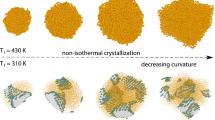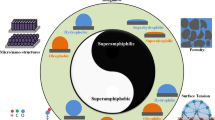Abstract
Studies show that the formation of breath figures over polystyrene is not clearly understood—sometimes the patterns are regular and sometimes they are barely formed. In an attempt to understand this process a little more, breath figures over polystyrene of three molecular weights and on the smooth and grooved DVD surfaces are prepared and studied. The microporous films are prepared by the evaporation of the chloroform solution of the polymers in a humid environment. The thus formed breath figure patterns are studied under a confocal laser scanning microscope and the images are analyzed. Breath figures were formed for (a) three molecular weights of the polymer (b) two casting techniques, and (c) on smooth and grooved surfaces (of a commercial DVD). The wetting of the breath figures formed by water is also reported here. The pore diameters were found to increase with increase in molecular weight and also with concentration of the polymer used. Only drop-casting method yield breath figures. Voronoi entropy, calculated from the images, indicates ordered pores on the grooved surface compared to smooth surfaces. Contact angle studies indicate a hydrophobic nature of the polymer, with the hydrophobicity increasing by the patterning.
Graphical abstract









Similar content being viewed by others
Data availability
The datasets generated and/or analyzed during the current study are available from the corresponding author on reasonable request.
References
P.T. Tanev, M. Chibwe, T.J. Pinnavaia, Titanium-containing mesoporous molecular sieves for catalytic oxidation of aromatic compounds. Nature 368, 321–323 (1994). https://doi.org/10.1038/368321a0
H. Deleuze, X. Schultze, D.C. Sherrington, Polymer-supported titanates as catalysts for transesterification reactions. Polymer 39, 6109–6114 (1998). https://doi.org/10.1016/S0032-3861(98)00080-9
K. Lewandowski, P. Murer, F. Svec, J.M.J. Fréchet, The design of chiral separation media using monodisperse functionalized macroporous beads: effects of polymer matrix, tether, and linkage chemistry. Anal. Chem. 70, 1629–1638 (1998). https://doi.org/10.1021/ac971196x
D.B. Akolekar, A.R. Hind, S.K. Bhargava, Synthesis of macro-, meso-, and microporous carbons from natural and synthetic sources, and their application as adsorbents for the removal of quaternary ammonium compounds from aqueous solution. J. Colloid Interface Sci. 199, 92–98 (1998). https://doi.org/10.1006/jcis.1997.5352
S. Xie, F. Svec, J.M.J. Fréchet, Rigid porous polyacrylamide-based monolithic columns containing butyl methacrylate as a separation medium for the rapid hydrophobic interaction chromatography of proteins. J. Chromatogr. A 775, 65–72 (1997). https://doi.org/10.1016/S0021-9673(97)00254-9
B. François, O. Pitois, J. François, Polymer films with a self-organized honeycomb morphology. Adv. Mater. 7, 1041–1044 (1995). https://doi.org/10.1002/adma.19950071217
H. Yabu, Fabrication of honeycomb films by the breath figure technique and their applications. Sci. Technol. Adv. Mater. 19, 802–822 (2018). https://doi.org/10.1080/14686996.2018.1528478
O. Karthaus, N. Maruyama, X. Cieren, M. Shimomura, H. Hasegawa, T. Hashimoto, Water-assisted formation of micrometer-size honeycomb patterns of polymers. Langmuir 16, 6071–6076 (2000). https://doi.org/10.1021/la0001732
M. Srinivasarao, D. Collings, A. Philips, S. Patel, Three-dimensionally ordered array of air bubbles in a polymer film. Science 292, 79–83 (2001). https://doi.org/10.1126/science.1057887
B. de Boer, U. Stalmach, H. Nijland, G. Hadziioannou, Microporous honeycomb-structured films of semiconducting block copolymers and their use as patterned templates. Adv. Mater. 12, 1581–1583 (2000). https://doi.org/10.1002/1521-4095(200011)12:21%3c1581::AID-ADMA1581%3e3.0.CO;2-R
G. Widawski, M. Rawiso, B. François, Self-organized honeycomb morphology of star-polymer polystyrene films. Nature 369, 387–389 (1994). https://doi.org/10.1038/369387a0
M.H. Stenzel-Rosenbaum, T.P. Davis, A.G. Fane, V. Chen, Porous polymer films and honeycomb structures made by the self-organization of well-defined macromolecular structures created by living radical polymerization techniques. Angew. Chem. Int. Ed. 40, 3428–3432 (2001). https://doi.org/10.1002/1521-3773(20010917)40:18%3c3428::AID-ANIE3428%3e3.0.CO;2-6
J. Peng, Y. Han, Y. Yang, B. Li, The influencing factors on the macroporous formation in polymer films by water droplet templating. Polymer 45, 447–452 (2004). https://doi.org/10.1016/j.polymer.2003.11.019
E. Bormashenko, R. Pogreb, O. Stanevsky, Y. Bormashenko, O. Gendelman, Formation of honeycomb patterns in evaporated polymer solutions: influence of the molecular weight. Mater. Lett. 59, 3553–3557 (2005). https://doi.org/10.1016/j.matlet.2005.06.026
E. Ferrari, P. Fabbri, F. Pilati, Solvent and substrate contributions to the formation of breath figure patterns in polystyrene films. Langmuir 27, 1874–1881 (2011). https://doi.org/10.1021/la104500j
M.H. Stenzel, C. Barner-Kowollik, T.P. Davis, Formation of honeycomb-structured, porous films via breath figures with different polymer architectures. J. Polym. Sci. Part Polym. Chem. 44, 2363–2375 (2006). https://doi.org/10.1002/pola.21334
L. Ruiz-Rubio, I. Azpitarte, N. García-Huete, J.M. Laza, J.L. Vilas, L.M. León, Solvent and relative humidity effect on highly ordered polystyrene honeycomb patterns analyzed by Voronoi tesselation. J. Appl. Polym. Sci. (2016). https://doi.org/10.1002/app.44004
A.V. Limaye, R.D. Narhe, A.M. Dhote, S.B. Ogale, Evidence for convective effects in breath figure formation on volatile fluid surfaces. Phys. Rev. Lett. 76, 3762–3765 (1996). https://doi.org/10.1103/PhysRevLett.76.3762
B.-H. Wu, L.-W. Wu, K. Gao, S.-H. Chen, Z.-K. Xu, L.-S. Wan, Self-assembly of patterned porous films from cyclic polystyrenes via the breath figure method. J. Phys. Chem. C 122, 3926–3933 (2018). https://doi.org/10.1021/acs.jpcc.7b12286
W. Dong, Y. Zhou, D. Yan, Y. Mai, L. He, C. Jin, Honeycomb-structured microporous films made from hyperbranched polymers by the breath figure method. Langmuir 25, 173–178 (2009). https://doi.org/10.1021/la802863m
S. Zhai, J.-R. Ye, N. Wang, L.-H. Jiang, Q. Shen, Fabrication of porous film with controlled pore size and wettability by electric breath figure method. J Mater Chem C. 2, 7168–7172 (2014). https://doi.org/10.1039/C4TC01271B
K. Nilavarasi, V. Madhurima, Controlling breath figure patterns on PDMS by concentration variation of ethanol-methanol binary vapors. Eur. Phys. J. E. 41, 82 (2018). https://doi.org/10.1140/epje/i2018-11691-x
W. Cai, D. Xu, L. Qian, J. Wei, C. Xiao, L. Qian, Z. Lu, S. Cui, Force-induced transition of π–π stacking in a single polystyrene chain. J. Am. Chem. Soc. 141, 9500–9503 (2019). https://doi.org/10.1021/jacs.9b03490
Y. Xu, B. Zhu, Y. Xu, A study on formation of regular honeycomb pattern in polysulfone film. Polymer 46, 713–717 (2005). https://doi.org/10.1016/j.polymer.2004.12.001
A.M. Rawlett, J.A. Orlicki, N. Zander, A. Karikari, T. Long, T, Self assembled, ultra-hydrophobic micro/nano-textured surfaces. Army Research Lab Aberdeen Proving Ground MD Weapons and Materials Research (2007)
H. Matsuyama, K. Ohga, T. Maki, M. Teramoto, The effect of polymer molecular weight on the structure of a honeycomb patterned thin film prepared by solvent evaporation. J. Chem. Eng. Jpn. 37, 588–591 (2004). https://doi.org/10.1252/jcej.37.588
B. Zhao, C. Li, Y. Lu, X. Wang, Z. Liu, J. Zhang, Formation of ordered macroporous membranes from random copolymers by the breath figure method. Polymer 46, 9508–9513 (2005). https://doi.org/10.1016/j.polymer.2005.07.035
Y. Zhu, R. Sheng, T. Luo, H. Li, J. Sun, S. Chen, W. Sun, A. Cao, Honeycomb-structured films by multifunctional amphiphilic biodegradable copolymers: surface morphology control and biomedical application as scaffolds for cell growth. ACS Appl. Mater. Interfaces 3, 2487–2495 (2011)
H. Li, Y. Jia, M. Du, J. Fei, J. Zhao, Y. Cui, J. Li, Self-organization of honeycomb-like porous TiO2 films by means of the breath-figure method for surface modification of titanium implants. Chem. Eur. J. 19, 5306–5313 (2013). https://doi.org/10.1002/chem.201203353
B.S. Yilbas, A. Al-Sharafi, H. Ali, Surfaces for Self-Cleaning, in Self-Cleaning of Surfaces and Water Droplet Mobility. (Elsevier, 2019), pp.45–98
P.J. Flory, Principles of Polymer Chemistry (Cornell University Press, 1953)
Y. Hong, Electrospun Fibrous Polyurethane Scaffolds in Tissue Engineering, in Advances in Polyurethane Biomaterials. (Elsevier, 2016), pp.543–559
D.W. Schubert, Spin coating as a method for polymer molecular weight determination. Polym. Bull. 38, 177–184 (1997). https://doi.org/10.1007/s002890050035
J.S. Park, S.H. Lee, T.H. Han, S.O. Kim, Hierarchically ordered polymer films by templated organization of aqueous droplets. Adv. Funct. Mater. 17, 2315–2320 (2007). https://doi.org/10.1002/adfm.200601141
C.M. Knobler, D. Beysens, Growth of breath figures on fluid surfaces. Europhys. Lett. EPL 6, 707–712 (1988). https://doi.org/10.1209/0295-5075/6/8/007
A. Muñoz-Bonilla, M. Fernández-García, J. Rodríguez-Hernández, Towards hierarchically ordered functional porous polymeric surfaces prepared by the breath figures approach. Prog. Polym. Sci. 39, 510–554 (2014). https://doi.org/10.1016/j.progpolymsci.2013.08.006
E. Bormashenko, M. Frenkel, A. Vilk, I. Legchenkova, A. Fedorets, N. Aktaev, L. Dombrovsky, M. Nosonovsky, Characterization of self-assembled 2D patterns with voronoi entropy. Entropy 20, 956 (2018). https://doi.org/10.3390/e20120956
C. Annic, J.P. Troadec, A. Gervois, J. Lemaître, M. Ammi, L. Oger, Experimental study of radical tesselations of assemblies of discs with size distribution. J. Phys. I(4), 115–125 (1994). https://doi.org/10.1051/jp1:1994124
T. Young, III. An essay on the cohesion of fluids. Philos. Trans. R. Soc. Lond. 95, 65–87 (1805). https://doi.org/10.1098/rstl.1805.0005
B.-B. Ke, L.-S. Wan, Y. Li, M.-Y. Xu, Z.-K. Xu, Selective layer-by-layer self-assembly on patterned porous films modulated by Cassie-Wenzel transition. Phys. Chem. Chem. Phys. 13, 4881–4887 (2011). https://doi.org/10.1039/C0CP01229G
E. Bormashenko, Y. Bormashenko, G. Whyman, R. Pogreb, O. Stanevsky, Micrometrically scaled textured metallic hydrophobic interfaces validate the Cassie-Baxter wetting hypothesis. J. Colloid Interface Sci. 302, 308–311 (2006). https://doi.org/10.1016/j.jcis.2006.06.016
Acknowledgements
Swathi P V acknowledges DST, Govt. of India for the Inspire Fellowship (IF190317). The authors acknowledge S G Ramkumar for giving the idea of spin-coating. The authors acknowledge Chandra Mouli P V S S R for the discussions on image analysis. The authors acknowledge Abdulkareem U for running the MD simulation of PS. The authors thank the Naval Research Board of India for the contact angle goniometer.
Author information
Authors and Affiliations
Contributions
VM conceived the original idea. SPV performed the experiments. Both the authors were involved equally in the analysis of the results and writing the manuscript.
Corresponding author
Ethics declarations
Conflict of interest
The authors declare no conflict of interest.
Rights and permissions
Springer Nature or its licensor (e.g. a society or other partner) holds exclusive rights to this article under a publishing agreement with the author(s) or other rightsholder(s); author self-archiving of the accepted manuscript version of this article is solely governed by the terms of such publishing agreement and applicable law.
About this article
Cite this article
Swathi, P.V., Madhurima, V. Porous polymer film formation by water droplet templating using polystyrene. Eur. Phys. J. E 46, 25 (2023). https://doi.org/10.1140/epje/s10189-023-00282-x
Received:
Accepted:
Published:
DOI: https://doi.org/10.1140/epje/s10189-023-00282-x




